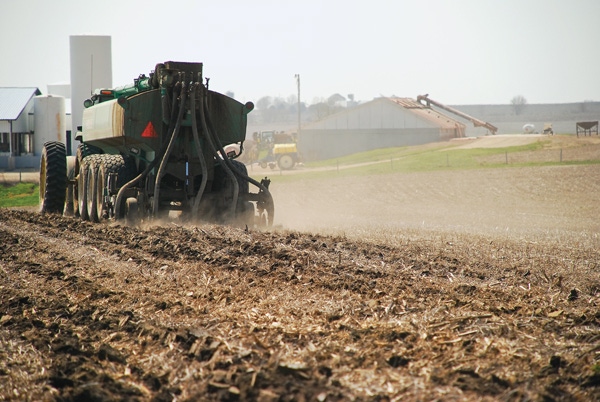Tips for Drought Application
This year’s drought has producers wondering what early harvest means for early manure application. Iowa State University (ISU) specialists provide some observations and some solutions to those concerns.

This year’s drought has producers wondering what early harvest means for early manure application. Iowa State University (ISU) specialists provide some observations and some solutions to those concerns.
In normal years, soybean harvest is first, says Kris Kohl, field specialist/agricultural engineer in Storm Lake, IA. However, the extra number of growing units for the 2012 corn crop due to persistent hot weather means that the crop is significantly ahead of normal growth and will likely be harvested first. Soybean growth appears normal in Iowa, at least, and should be harvested right on time in mid-September.
Application Goals
The goal of manure application is to ensure that nutrients are properly applied and available for next year’s plantings. “A majority of the nitrogen that’s in manure is in the ammonia form. If we spread it on the surface and it evaporates, everyone can smell it,” Kohl explains. “If it is properly knifed into the soil, you can’t smell it, and very, very little of the nitrogen is lost into the atmosphere.”
Knifing in manure and getting it covered well will be more difficult due to dry, hard soils. Kohl says follow your nose to assure manure is properly knifed in. It could take a bigger tractor and slower application times to get the job done properly.
Some producers might be tempted to apply manure early this year, but from a nitrogen-management perspective, that wouldn’t be preferable, warns Daniel Andersen, Manure Management and Water Quality, Agricultural and Biosystems Engineering at ISU in Ames, IA.
“It’s important to delay manure application until soil temperature cools to below 50°F and stays there consistently,” he says. During manure application, the ammonia in manure converts to nitrates. By delaying application until soil temperatures are cooler, the soils can retain nitrates instead of them
leaching away, Kohl explains.
The lack of moisture this year actually proves beneficial in that nitrogen will be less likely to drain away via tiles. “The dry weather will allow us to put manure on earlier, but the risk of manure nutrients being lost is low because the soils have so much storage capacity in them throughout most of the Corn Belt,” Kohl says.
In many fields where yield goals aren’t expected to be met, applied nutrients, such as phosphorus, will remain in the root zone and be available for next year’s crop, Andersen says. “Producers applying manure based on phosphorus limits should consider soil testing and adjusting application accordingly.”
Soil Cracks
Another concern in extremely dry conditions is the potential for large soil cracks to develop. “These can serve as direct conduits between the applied manure and tiles,” Andersen says. “Fields should be assessed before application to determine if this is an issue. If soil cracking is noted, producers should consider performing some tillage to break up the cracking. Make several passes, applying manure at shallower depths with each pass. And have an emergency response plan in place to respond to any manure reaching tiles.”
Know where the tile inlets and outlets are and how to block the tile outlets, and have telephone numbers and other emergency information on hand, Andersen suggests.
Kohl says these concerns are greater in states like Ohio, where some soils have cracks that go all the way to the tile lines. In Iowa, very few cracks are 4 ft. deep.
Typical liquid manure application rates average 3,000-4,000 gal./acre, which will soak into the ground long before it reaches the tile lines, Kohl says. At that rate, corn and soybean crops for next year will have all of the nitrogen, phosphorus and potassium nutrients they will need.
Application Precautions
The Iowa Department of Natural Resources (DNR) advises producers to take precautions when applying manure this fall.
Cracks in the soil can have unintended consequences, says Cindy Martens, an environmental specialist in the DNR’s Spencer field office.
“Farmers think it’s dry and the liquid manure will just soak in. They may want to irrigate to provide moisture to the crop, but often they don’t realize how fast it can travel straight to a tile line and then into a stream. We just want people to be aware that it can be a problem so they can do something about it,” she explains.
The DNR says producers with lagoons should check the berms of earthen basins frequently. If there are large cracks or signs of leakage, they may need to wet down the berm or fill the cracks.
The DNR has provided the following list of tips to reduce the risk of manure reaching a stream:
• Check for cracks in the soil before applying manure. If soils are cracked, delay application until soil moisture increases, if possible.
• Find all underground tile inlets and where tile line outlets reach streams or ponds. Cover or block off any inlets.
• Have an emergency spill kit and information on hand before application.
• Check the nutrient or manure management plan for required separation distances to bodies of water and other sensitive areas.
• Consider a setback for injected manure, even when it’s not required.
• Apply manure at the slowest possible rate.
• Move hoses and irrigation equipment frequently.
• Check tile outlets before, during and after application.
• If it rains or the outlet is discharging, check tile outlets and bodies of water below the outlet for odor, solids and impacts on fish or other aquatic life.
• Stop applying manure immediately if there is a discharge.
• Contain and clean up any spilled manure.
Pit Foaming
Iowa State’s Kohl says ongoing research indicates that the pit foaming problem associated with feeding rations containing high levels of distiller’s dried grains with solubles (DDGS) is due to the corn oil that floats on top, trapping the methane and carbon dioxide produced by microbes near the bottom of the pits. The result is buildup of foam on the manure that can flow up through the slats and explode if the foam breaks up quickly from agitation or sprinkling and a spark ignites it.
In preliminary trials, Kohl has had good success adding household ammonia to pits. He added 7 gallons to an 8-ft.-deep pit in a 1,000-head barn with a foaming problem. In just five days, foam went from 16 in. deep down to just 5 in.
“As long as the pigs are in the building, manure from the pigs breaks down some of the foam. But as soon as you remove the pigs, wash things down and shut down the ventilation, the foam can grow and come through the slats. If there is a spark from a light switch, fan or heater and the methane concentration is right, then it will explode,” Kohl says.
But sometimes it can happen when pigs are still in the building. Last year, a producer walked into a barn he was agitating with the curtains up. He flipped the light switch on and the methane exploded. He was burned over 80% of his body and only lived for about a day and a half. The pigs were a total loss.
Selling Manure
With fertilizer prices so high, the question becomes, how much can I sell my manure for?
A simple answer, says Kohl, is to pick a typical fall application date, say Nov. 15, and ask the local elevator what the price of fertilizer, custom-applied to the field, would be. This assumes that the hog farmer would apply the manure to the field just like having the elevator apply the fertilizer.
Set a price for manure that is 80-90% of the elevator’s fertilizer price as a starting point for negotiations, he explains.
Even at 80 cents on a dollar for the cost of manure vs. fertilizer, manure will normally out-yield fertilizer by about 10% in crop nutrient production, Kohl says.
“You are getting all of the organic matter in manure, plus the micronutrients and a tiny bit of water, too, which all adds up when you are in a drought,” he says.
About the Author(s)
You May Also Like





